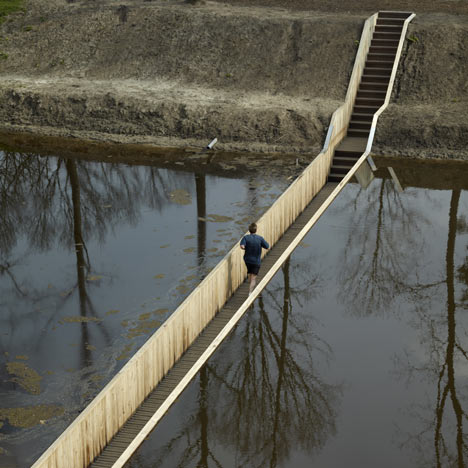This bridge across the moat of a historic Dutch fort leads visitors below the water’s surface without getting them wet.
Designed by architects RO&AD of the Netherlands and Belgium, the Sunken Bridge is an access route to the Fort de Roovere, which is part of a line of 17th century defence structures.
Unlike a conventional bridge, the structure is invisible from a distance and has little impact on surrounding views towards the fort.
Processed timber retaining walls that will resist decay separate the walkway from the surrounding still waters.
Another concealed walkway we've featured leads behind a mirror into a secret tunnel - readmore about that project here.
Here's some more text from timber supplier Accoya:
The West Brabant Water Line is a 17th century Dutch defensive line of earthen forts and walls that linked and protected a number of cities and villages during attacks from France and Spain; inundation zones were flooded with water too deep for enemy advance on foot but shallow enough to rule out use of boats.
As part of a recent restoration project, RO&AD architects sought to build access to the line’s Fort de Roovere, the largest fortress surrounded by a moat, while still preserving the site’s aesthetic integrity and dramatic view.
The team’s solution was a “sunken” bridge that sits within the water and slope. Following the line of the fort slope and sitting almost flush with the soil and the water level, the Moses Bridge is practically invisible as visitors approach and boasts a trench-like aesthetic.
Built with Accsys Technologies’ Accoya wood sheet piling on either side with a hardwood deck and stairs in between, the Moses Bridge is not only visually striking and highly functional, but also durable and eco friendly.
Accoya wood undergoes a nontoxic proprietary modification process called acetylation that renders it an unrecognizable wood source, preventing fungal decay while increasing its dimensional stability.
Accoyawood is sourced from FSC- and PEFC-certified forests and is Cradle to Cradle Gold certified.
Click above for larger image

